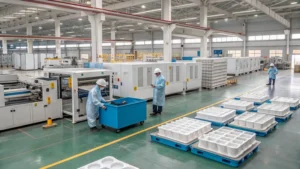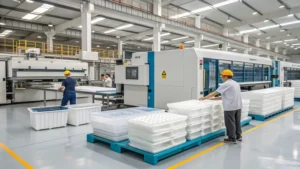
Thermoforming is a versatile manufacturing process used across industries like packaging, automotive, and medical devices to create complex shapes from plastic sheets. However, one persistent challenge in thermoforming is managing thickness changes1—variations in the wall thickness of the final product that can impact its strength, appearance, and functionality. This blog post explores the root causes of these thickness variations and offers insights into how they can be controlled to optimize product quality.
Thickness changes in thermoformed products are primarily caused by stretching during the forming process, influenced by mold design, forming methods, process parameters, and material properties.
By delving into these factors, manufacturers can better understand and mitigate thickness variations, ensuring consistent and high-performing products.
Thickness changes in thermoforming are unavoidable but can be managed.True
While stretching inherently causes some variation, strategic design and process adjustments can minimize its impact.
Thickness changes only occur due to mold design.False
Mold design is a key factor, but material properties and process settings also significantly contribute to thickness variations.
- 1. What is Thermoforming and Why Do Thickness Changes Occur?
- 2. How Do Different Forming Methods Affect Thickness Changes?
- 3. What Role Do Process Parameters Play in Thickness Changes?
- 4. How Do Material Properties Influence Thickness Changes?
- 5. What Are Practical Ways to Manage Thickness Changes?
- 6. Conclusion
What is Thermoforming and Why Do Thickness Changes Occur?
Thermoforming involves heating a plastic sheet to a pliable state, shaping it over a mold, and trimming it into a final product. Thickness changes arise as the plastic stretches during forming, leading to thinner walls in some areas and thicker ones in others. These variations are influenced by multiple factors, including mold design, forming techniques, process conditions, and the properties of the plastic used.
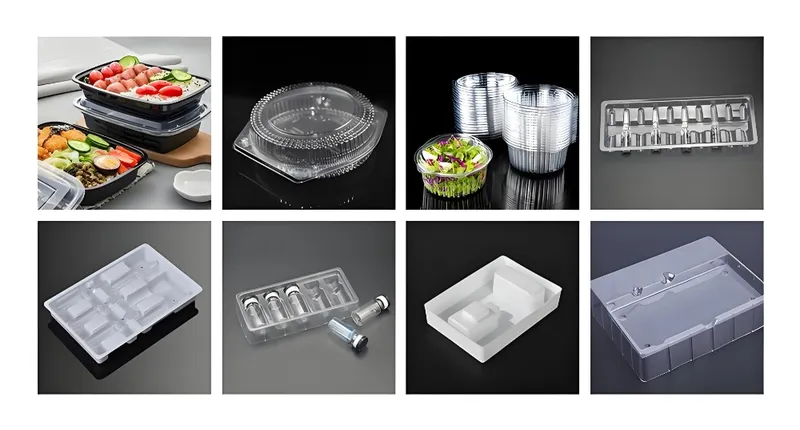
Thermoforming heats a plastic sheet and molds it, with thickness changes resulting from stretching, driven by mold complexity, material behavior, and process controls.
| Factor | Impact on Thickness |
|---|---|
| Mold Design2 | Sharp angles and deep draws increase stretching |
| Material Properties3 | Stretch resistance varies by plastic type |
| Process Parameters | Temperature and pressure affect material flow |
Mold Design and Complexity
Molds with deep cavities or intricate shapes require the plastic to stretch more in certain areas, thinning the walls. For example, a deep tray will have thinner sides and bases compared to flatter sections.
Forming Method
Techniques like vacuum forming, pressure forming, and plug-assisted forming influence how evenly the plastic stretches. Vacuum forming4, for instance, may thin out deep sections more than pressure forming.
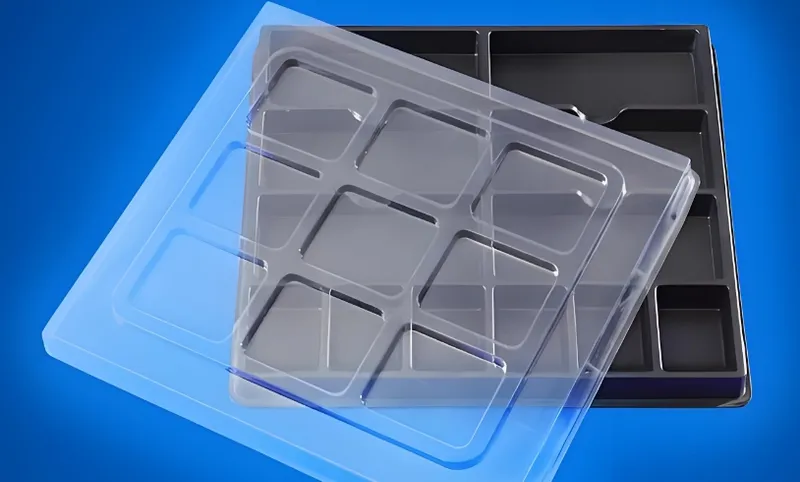
Process Parameters
Temperature, heating time, and pressure settings dictate how the plastic flows. Uneven heating can cause inconsistent stretching, while improper pressure may exaggerate thinning.
Material Properties
Thermoplastics like PET, PVC, and polystyrene5 stretch differently. PET may thin more in deep draws, while PVC’s rigidity can resist excessive stretching if heated properly.
Mold design is the primary cause of thickness changes in thermoforming.False
While influential, mold design is one of several factors, including material choice and process parameters.
Using plug-assisted forming can help reduce thickness variations.True
Plug-assisted forming pre-stretches the sheet evenly, improving thickness consistency.
How Do Different Forming Methods Affect Thickness Changes?
The method used to shape the plastic sheet plays a critical role in thickness distribution. Each technique applies force differently, affecting how the material stretches and conforms to the mold.
Vacuum forming, pressure forming, and plug-assisted forming6 each impact thickness differently, with plug-assisted forming often yielding the most uniform results.
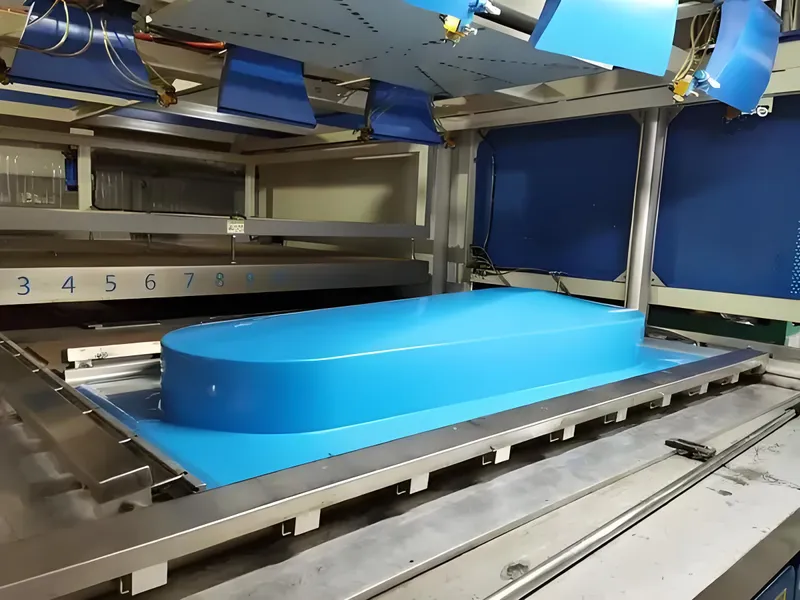
Vacuum Forming
This method uses a vacuum to pull the heated sheet onto the mold. It’s cost-effective but can result in uneven thickness, especially in deep parts where the base thins significantly.
Pressure Forming
By applying positive air pressure, this technique pushes the sheet onto the mold, offering better control and more uniform thickness, particularly for detailed designs.
Plug-Assisted Forming
A plug pre-stretches the sheet before it contacts the mold, distributing the material more evenly. This reduces thinning in complex or deep parts.
Vacuum forming always results in uneven thickness.False
While it can lead to unevenness, proper mold design and process tweaks can improve consistency.
Plug-assisted forming is the best method for achieving uniform thickness.True
Its pre-stretching mechanism ensures more even material distribution.
What Role Do Process Parameters Play in Thickness Changes?
Process parameters—such as temperature, heating duration, and pressure—directly affect how the plastic behaves during forming, influencing thickness uniformity.
Forming temperature, heating time, and pressure7 control the plastic’s flow and stretch, impacting thickness distribution.

Forming Temperature
Too low a temperature restricts even stretching, while excessive heat can cause thinning or tearing. The ideal range depends on the material.
Heating Time
Uneven or insufficient heating creates hot spots, leading to inconsistent stretching and thickness variations across the part.
Pressure Levels
In pressure forming, higher pressure enhances mold detail but can stretch certain areas more, while low pressure may leave thickness uneven.
Higher forming temperatures always lead to thinner walls.False
Higher temperatures increase flow, but balance with other factors prevents excessive thinning.
Uniform heating is essential for consistent thickness distribution.True
Even heating ensures uniform pliability, reducing uneven stretching.
How Do Material Properties Influence Thickness Changes?
The choice of thermoplastic affects how the sheet stretches and, thus, the thickness of the final product. Each material has unique characteristics that influence its forming behavior.
Thermoplastics like PET, PVC, and polystyrene exhibit different stretching properties, affecting thickness outcomes in thermoforming.

PET (Polyethylene Terephthalate)
Widely used in packaging, PET offers clarity and strength but thins more in deep draws, requiring careful mold planning.
PVC (Polyvinyl Chloride)
PVC’s rigidity resists excessive stretching, but uneven heating can still cause thickness inconsistencies.
Polystyrene
Common in disposable items, polystyrene stretches relatively evenly but demands precise temperature control to avoid over-thinning.
All thermoplastics behave the same way in thermoforming.False
Each material’s unique properties lead to distinct stretching and thickness patterns.
Material selection is crucial for managing thickness changes.True
Matching material stretch behavior to the part’s needs improves thickness control.
What Are Practical Ways to Manage Thickness Changes?
Controlling thickness variations requires a holistic approach, combining smart design, precise process control, and informed material choices.
Minimize thickness changes through optimized mold design8, uniform heating, suitable forming methods, and tailored material selection.

Design Checklist for Managing Thickness
-
Mold Design: Use gradual transitions and avoid sharp corners to limit excessive stretching.
-
Uniform Heating9: Ensure consistent sheet temperature to prevent uneven flow.
-
Forming Method: Opt for plug-assisted forming for complex parts needing even thickness.
-
Material Selection10: Pick plastics with stretching properties suited to the design.
Process Selection Decision-Making
Consider thermoforming when:
-
Cost-Effectiveness: It’s ideal for low-to-medium runs and prototyping.
-
Complexity: It handles intricate shapes, though thickness needs management.
-
Material Use: It excels with thin-walled parts but lacks injection molding’s precision for high volumes.
Thickness changes can be completely eliminated with the right techniques.False
Some variation is inherent, but it can be significantly reduced.
Careful mold design and process control can significantly reduce thickness variations.True
Optimization of these elements enhances thickness uniformity.
Conclusion
Thickness changes in thermoformed products stem from the stretching of the plastic sheet during forming, driven by mold design, forming methods, process parameters, and material properties. While these variations can’t be entirely eliminated, they can be effectively managed through thoughtful design, precise process adjustments, and strategic material choices. Understanding these causes empowers manufacturers to enhance product quality, performance, and cost-efficiency.
-
Understanding the causes of thickness changes can help manufacturers improve product quality and consistency in thermoforming processes. ↩
-
Exploring mold design's impact on thickness can lead to better product outcomes and optimized manufacturing processes. ↩
-
Learning about material properties can enhance the selection process for better thermoformed products and reduce defects. ↩
-
Explore this link to understand the pros and cons of vacuum forming, a key technique in plastic shaping, and how it affects thickness distribution. ↩
-
Learning about these materials will enhance your knowledge of their applications and performance in various forming techniques. ↩
-
Understanding these forming techniques can help you choose the best method for achieving uniform thickness in your projects. ↩
-
Understanding these parameters is crucial for optimizing plastic forming processes and achieving desired thickness uniformity. ↩
-
Learning about mold design strategies can significantly enhance the quality and consistency of thermoformed products. ↩
-
Discover the importance of uniform heating in thermoforming to ensure consistent product quality and performance. ↩
-
Understanding material selection is crucial for optimizing thermoforming processes and achieving desired product characteristics. ↩



